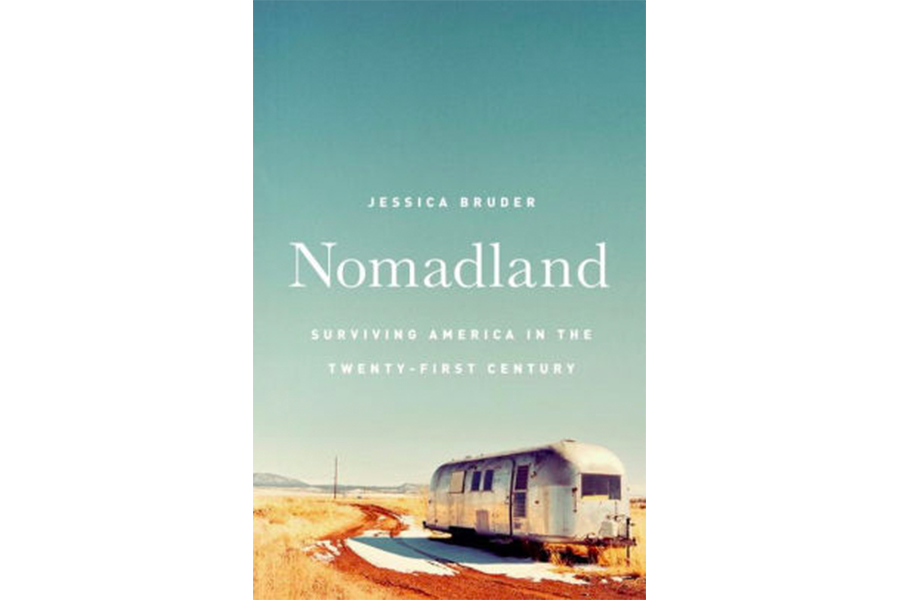'Nomadland' chronicles Americans on the move with heaps of reportorial detail, narrative flair
Loading...
In Nomadland: Surviving America in the Twenty-First Century, writer Jessica Bruder is pursuing a moving target: the new class of Americans who have traded in real estate for “wheel estate,” having lost their mortgages, their savings, and their dreams in the Great Recession or individual disasters, to become “workampers.” This tribe pulls into campgrounds, back roads, and parking lots, working temporary minimum-wage-variety jobs that sometimes come with a campsite. They live out of houses that move: fitted-out RVs, trailers, trucks, vans, even cars.
Bruder tackles her task with heaps of reportorial detail and narrative flair. First she hits us with the facts: “As I write this, there are only a dozen counties and one metro area in America where a full-time minimum wage worker can afford a one-bedroom apartment at fair market rent,” Bruder writes.
She reports on the exact costs of the RV and makeshift vans we encounter; how to set up a 100-watt solar panel in a rigged-out van; how much the bargain breakfast costs at the local diner; and how much it costs to get a shower at a truck stop. She reports exactly how many RV parks there are in Quartzite, Ariz. and how much it costs to camp there and where to “boondock,” or camp without amenities, on public land outside of town. She “FOIAs” (submits a Freedom of Information Act request to) the US Forest Service.
But while her prices and statistics punctuate the narrative, Bruder also manages to tap into the spiritual, the metaphorical, and the hopeful.
“As I write it is autumn. Soon winter will come,” she says. “Routine layoffs will start at the seasonal jobs. The nomads will pack up camp and return to their real home – the road – moving like blood cells through the veins of the country.… All will count the miles, which unspool like a film strip across America.”
On this journey, readers get to know characters like Charlene Swankie or “Swankie Wheels,” generous Silvianne the astrologer, and Linda May, who dreams of buying a piece of land and building an Earthship house for herself in Arizona’s dangerous desert country. (There are also former accountants, insurance executives, corporate vice presidents, and community college teachers, living on the move.)
And we get to know their world – a world with its own language, its own landscapes, and its own networks. There’s GTGs, or get-togethers like the RTR, “Rubber Tramp Rendezvous.” There’s The Q, for Quartzite, Ariz., and CamperForce, Amazon’s branded seasonal-employment initiative, and boondocking, or van-living off the grid. And there’s the cyber world: an entire boondocking-bloggers network; the “vandwellers” thread on Reddit, the app that identifies friendly Walmart parking lots.
All of this, writes Bruder, is a remarkable bid to “transcend – the fraying social order” by people who have been let down by it, rebuilding their own “parallel world on wheels.”
But transcendence can be exhausting. It’s tempting to see the road-tripping lifestyle as part of a great American tradition (and some of these places also inspired John Steinbeck).
But perhaps promoting and mythologizing our way out of difficulties is a less-productive American tradition. Through slogans like “Work hard. Have fun. Make history.” and newsletters with tips and information about its seasonal “CamperForce,” Bruder reports that Amazon attracts hundreds (possibly thousands) of workers in its warehouses for strenuous, repetitive seasonal factory work. She describes an Amazon handout telling workers to expect to lift up to 50 pounds in 90-degree heat, while newsletters provide endless tips on avoiding injury and invites workampers to the “Hard Times” Depression-era themed dance.
Is this American resilience, or American denial? Bruder doesn’t shrink from the question:
“The truth was much more nuanced,” she writes, “but how could I access it?”
Bruder’s answer is to outfit a van named Halen and go on the road. The result is this up-close look at the workampers, their world, and what this moment says about America.
In Halen, Bruder spends three winter seasons and two years with the workampers. And when Linda May finally buys her parcel of desert but can’t afford to take off work even long enough to visit the site, Bruder steps in. Armed with water, sunblock, a cell phone, a laptop, and GPS, she heads out to the remote site and walks the property with Linda joining her by Skype until the heat shuts her laptop down.
Bruder goes gonzo with simple, open transparency, letting the reader know when she’s intruded on the narrative, and why, and then using her proximity to the story to tease out the meaning behind the reporting.
Eventually, she also takes a lot of showers in truck stops.
“When I was in Halen,” Bruder writes, “my address was everywhere. I slept at Flying J truck stops, Walmart Supercenters, a casino called Whiskey Pete’s, an abandoned gas station, barren deserts, mountain wildernesses, suburban streets.… Experiences like these were the background music to my reporting this book.”
Structurally, the analysis comes first; this is a solid work of reporting, not yet another memoir documenting a weird one-off personal experiment. But, one of the most intriguing paragraphs in the book is a footnote describing how Bruder scored her first truck-stop shower for free. Readers might come away with a longing to hear more about Bruder’s experiences and to share the revelations and growth involved in the journey from her viewpoint.
Ultimately, that viewpoint is a refreshingly optimistic one, even amidst the bleak analysis. Bruder not only writes what she sees, but she eloquently makes some sense of it.
“As much as food or shelter,” she writes, “we require hope. And there is hope on the road.”








